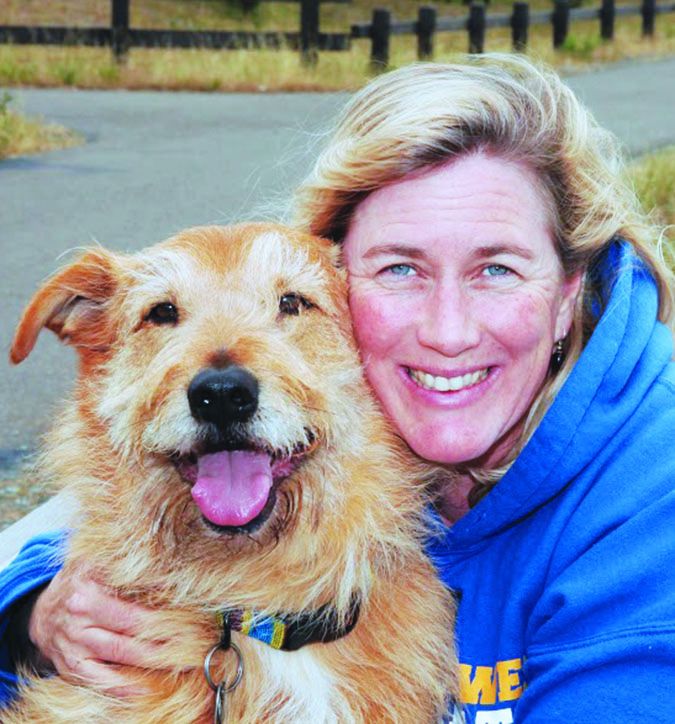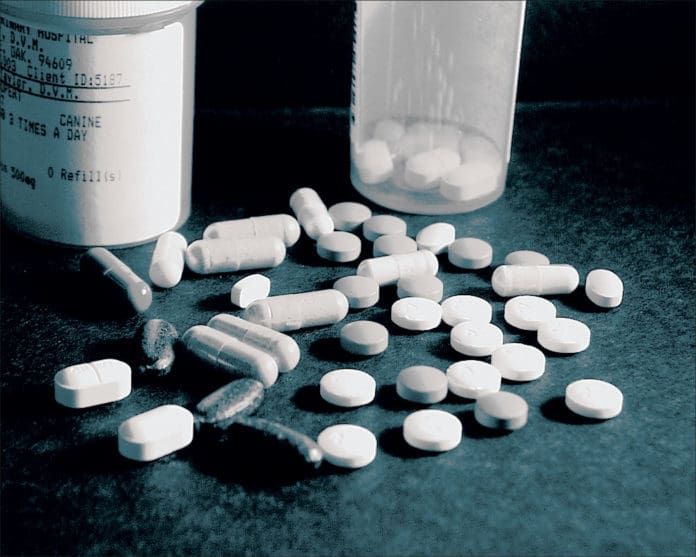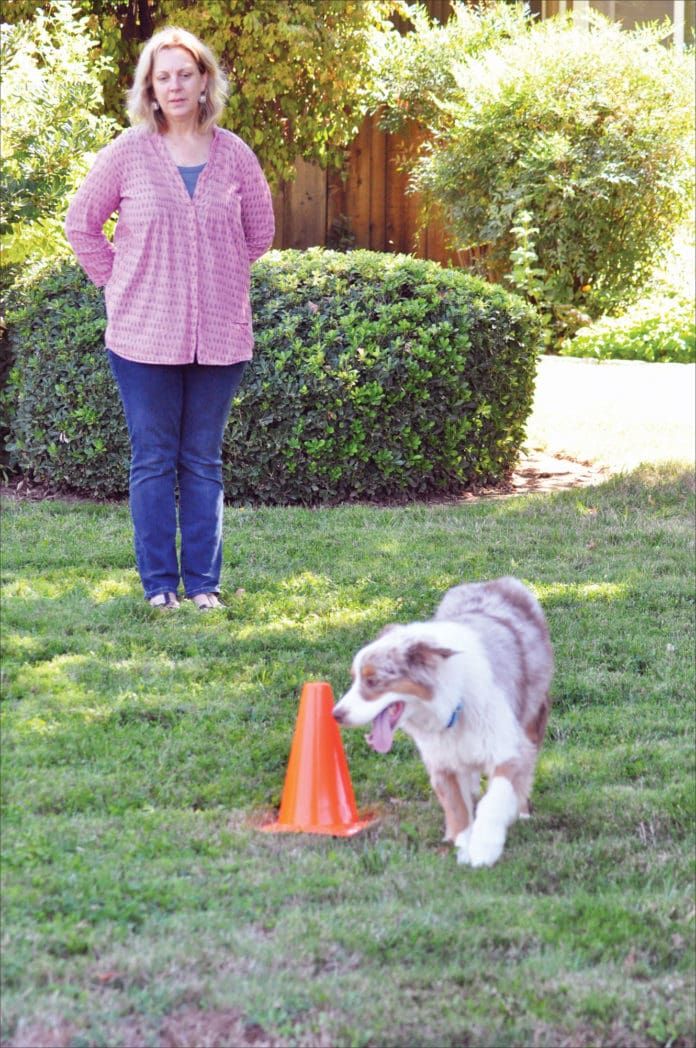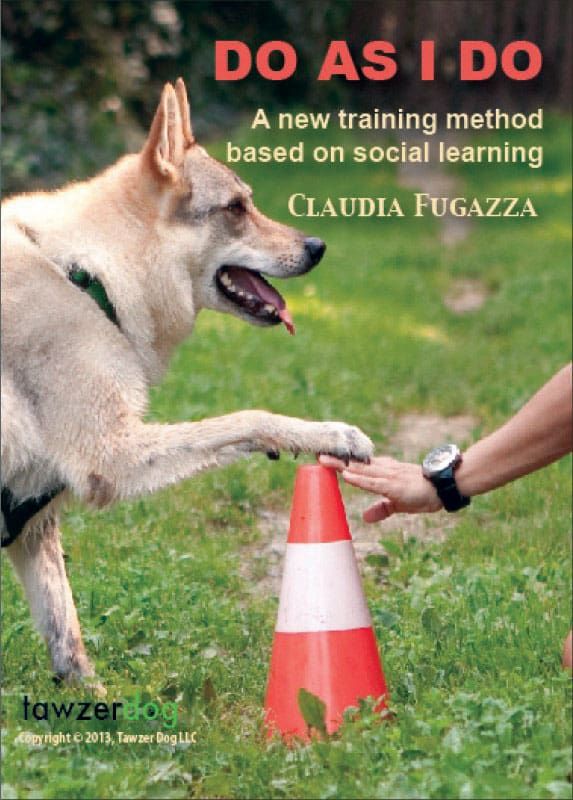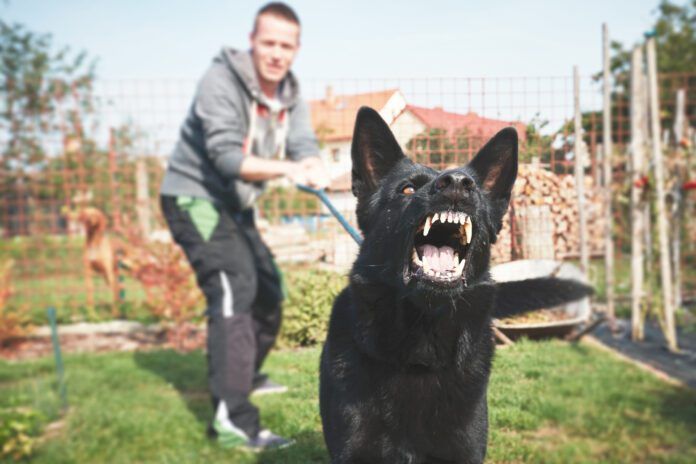Whole Dog Journal readers often try techniques and products described in the magazine, but sometimes years go by before we need something we read about, or it disappears from the market, or we have trouble finding it, or we simply forget all about it. Last month we revisited green tripe, Seacure, and Willard Water. Here are two more go-to products featured in previous issues that might now be perfect for you and your dog.
As we reported seven years ago (in “Accelerated Wound Healing,” WDJ August 2006), many products are marketed as a first-aid kit in a tube, jar, or bottle, but EMT Gel truly lives up to that description.
EMT Gel’s key ingredient, bovine collagen (also described as “a natural medical hydrolysate Type I collagen”), acts as a tissue adhesive, providing a matrix for new cell growth while sealing and protecting wounds and significantly reducing pain, bleeding, scarring, wound weeping, and the risk of infection.
Once applied, EMT Gel can be left undisturbed, which simplifies dressing changes. The collagen forms a plug that stops bleeding by encouraging clotting, and its occlusion of nerve endings reduces pain. Veterinarians in research universities and clinical practice recommend EMT Gel for abrasions, lacerations, skin ulcers, gunshot wounds, bites, first- and second-degree burns, electrical injuries, frostbite, post-surgical incisions, suture and IV sites, skin graft sites, bleeding ear injuries, skinned elbows, and other wounds.
According to its manufacturer, EMT Gel reduces bleeding, promotes rapid healing, reduces pain and itching, deodorizes wounds, protects wounds and newly formed tissue, provides an optimal environment for wound healing, is easy to use and cost-effective, conforms to wounds of all shapes and sizes, is naturally absorbent, has excellent adhesion qualities, is safe, non-toxic, and non-sensitizing, and can be used on all animals. Some users routinely apply it to their own injuries.
EMT Gel is sold in 1-ounce tubes and has a two-year shelf life.
A spray-on version (EMT Gel Spray) is available for the treatment of scrapes, first- and second-degree burns, scratches, lick granulomas, hot spots, and other skin injuries. In addition to wound-healing collagen, the nontoxic spray contains a bitter taste (Bitrex®, or denatonium benzoate) which deters many dogs from licking it off.
Websites featuring EMT Gel and Spray publish testimonials from users who credit the products with saving their dogs’ lives or at least making them more comfortable.
One of the happy users in our 2006 article was Shannon Rogers-Peisert of Liberty, Missouri, whose black Labrador Retriever, Cody, severed an artery while jumping a fence. “There was blood everywhere,” she says. “I had a sample tube of EMT Gel and thought to use it before taking Cody to the emergency clinic. The vet said it kept Cody from bleeding to death.”
In New Mexico in 2002, Troy Sparks spent quail season’s opening day hunting with Lucy, his Llewellyn Setter. When they returned to the truck, he noticed a blood clot on Lucy’s neck, and as he began to clean the wound, blood poured down her neck. Sparks applied EMT Gel, gauze, and vet wrap to hold it in place, then drove to Lucy’s veterinarian two hours away. When the vet removed the dressing, a six-inch stream of blood shot out. After getting stitches, Lucy recovered quickly.
In Athens, Georgia, Kevin Johnston competes in field trials with German Shorthaired Pointers. As Johnston’s mother, Linda Lowe, explained, “Lefty, who runs and quarters faster and harder than any dog we have ever owned, was running in a trial on grounds that were very hard and rocky. Lefty ran on Saturday. On his first point on Sunday, he held up a bleeding foot. All four of his feet had very raw pads, with some injuries as large as quarters.”
Johnston had recently competed in a Dog of the Year trial at which he was given a sample of EMT Gel. He cleaned Lefty’s paw pads with saline solution and applied EMT Gel, a procedure he repeated the next day. “We were sure Lefty would not be able to compete for several weeks,” said Lowe, “but within two days he was much better and after four days, his paw pads seemed to be completely healed. We were very impressed with how quickly this product worked.”
Warren Befort of Burlington, Kansas, reported that his 4-year-old pointer, Angie, is a prolific bird dog but prone to injury. “On several occasions,” he said, “she has cut herself in the field, requiring a visit to the vet to get sewn up. In the past, the trip to town could mean significant blood loss and lots of anguish.”
After reading about EMT Gel, Befort decided to keep a tube on hand. “The last time Angie sliced her tail,” he said, “the cut was over an inch long and fairly deep. I immediately broke out the EMT Gel, applied a liberal amount to the wound, covered it with gauze, and wrapped it with elastic tape. By the next morning the wound was noticeably better. I am now convinced not to go anywhere with Angie without taking the EMT Gel, too.”
BEST USE
To use EMT Gel, clean the wound by rinsing it with plain water or a saline solution; then apply the gel to the wound and the surrounding area. Allow superficial wounds to air-dry and, for deeper wounds, cover with a non-stick dressing. If using the spray, keep it away from the dog’s eyes and nose because of its bitter-tasting ingredient.
EMT Gel and Spray should be stored at room temperature and protected from freezing. Extreme heat may affect the gel’s viscosity but not its performance.
EMT Gel can be messy and may not stop heavy bleeding unless pressure is applied to the wound, and the spray can be slow to dry. In some cases, possibly because the product was old and because plain gauze rather than a non-stick dressing was used, the gel stuck like glue to paw pads or other injuries as well as to the gauze. Not all dogs are deterred by the spray’s bitter taste, in which case lick granulomas and similar wounds can be protected with bandaging or the use of an Elizabethan collar until the wound heals. Most users report good results for both the gel and spray on superficial wounds and wounds that are easily accessed.
Digestive Enzymes
Most WDJ readers are familiar with digestive enzymes, protein-like compounds that, in small amounts, speed biological reactions in the digestive process.
But enzymes do much more than react with food in the digestive tract. Many enzymes are cultivated for use in industrial processes, medical testing, food production, and as ingredients in household products such as pet stain removers, laundry detergents, toothpaste, and facial cleansers. Enzymes cause seeds to sprout, flowers to blossom, plants to grow, autumn leaves to change color, and fruits to ripen. Living animals manufacture thousands of enzymes for various functions throughout their bodies.
Some enzymes – called systemic oral enzymes – are swallowed and then absorbed into the bloodstream, where they affect the entire body, removing inflammation at its source and improving a variety of conditions. These include pancreatin, a pancreatic enzyme; papain, derived from papayas; and bromelain, derived from pineapples. Taken between meals, they move past the stomach to the small intestine, from which they travel throughout the body.
When we explored systemic oral enzyme therapy in January 2001 (“Enzyme Therapy for Quicker Canine Injury Recovery”) and October 2005 (“A Digestive Enzyme Supplement Helps Dogs Recover from Illness and Injury”), the leading brand for human and pet use was Wobenzym N, then manufactured by Naturally Vitamins, Inc.
Wobenzym N (which is usually referred to simply as Wobenzym) was developed in the 1950s in the United States by Drs. Max Wolf and Helen Benitez of Columbia University, who named the product “wo” for Wolf, “ben” for Benitez, and “zym” for enzymes. Their research showed that proteolytic (protein-digesting) enzymes have four significant properties when circulating through the body: they reduce inflammation, break down harmful fibrous tissue, reduce blood viscosity to prevent harmful clotting without the adverse side effects of aspirin and other blood-thinning medications, and support immune function.
Despite its benefits, Wobenzym did not become a successful over-the-counter remedy until it moved to Germany, where only aspirin outsells it. Wobenzym is also the most thoroughly researched enzyme supplement available worldwide, having been tested in over 100 medical studies and clinical trials, most of them conducted in Europe.
Wobenzym is recommended for bruises, sprains, and all types of sports injuries as well as arthritis and any illness that involves inflammation. The bioflavonoid rutin, one of Wobenzym’s ingredients, prevents the discoloration and pain associated with bruises. German surgeons routinely prescribe Wobenzym to prevent bruising, swelling, edema, and pain. It significantly reduces post-surgical recovery time, and German hospitals give large amounts to those with serious injuries to prevent brain swelling and speed recovery.
FORMS AND TYPES
For many years Wobenzym was available as beige tablets with a clear coating (a sugar-free product developed for the American market) and as red tablets containing a small amount of sugar in their coating (the European version). The red tablets were also sold under the brand name Fido-Wobenzym for use with dogs.
After our articles appeared, Naturally Vitamins replaced Wobenzym with Medizyme, which contains the same formula. Fido Wobenzym disappeared and was replaced by Medizyme Fido. Wobenzym N is now sold by the supplement maker Garden of Life and by Douglas Laboratories, which calls it Mucos Pharma Wobenzym N.
In addition to Wobenzym N, both Garden of Life and Douglas Laboratories sell the original German formula, Wobenzym PS, which stands for Professional Strength.
Wobenzym N, Medizym, and Medizym Fido contain the same six enzyme ingredients in identical proportions while Wobenzym PS contains only three enzymes. All are protected by enteric coatings that survive stomach acid and break down in the small intestine. (To compare products, scroll down and click on the “Comparing Ingredients” link.)
FlavenZym by VitaCost contains the same six enzymes as Wobenzym N and Medizym, though in slightly different proportions. Of the products described here, FlavenZym is the least expensive. Search online for proteolytic enzymes, systemic oral enzyme therapy, or enteric-coated enzymes and you’ll find additional products as well.
WHAT THEY DO
Systemic oral enzymes taken between meals on an empty stomach once or twice per day:
– Support the body’s natural inflammation response, resulting in reduced pain and swelling.
– Increase flexibility, mobility, strength, and range of motion.
– Support joint and tendon health.
– Temporarily relieve aches, pains, and muscle soreness resulting from everyday activities.
– Reduce recovery time after sports injuries, accidents, or surgery.
– Normalize blood flow at injury sites, resulting in rapid healing and the reduction of pain.
– Improve oxygenation and the reduction of edema (fluid retention and swelling).
– Reduce scarring.
– Improve respiratory problems, seasonal allergies, and sinus infections.
In addition, some human and veterinary studies have found that systemic oral enzyme therapy helps slow or prevent the spread of cancer.
DOSING YOUR DOG
For maximum effectiveness, systemic oral enzymes should be taken on an empty stomach at least 45 minutes to one hour before meals or at least one to two hours after.
When adapting over-the-counter human enzyme products for canine use, consider your dog’s weight. Label directions are appropriate for a 100-pound human. Considering the well-documented safety of enzyme products (note the cautions below before using), proportions can be approximate. For dogs over 80 pounds, the human dose is likely to be effective and well tolerated. For dogs weighing 50 pounds, cut the dosage in half; for those weighing 25 pounds, use one-fourth of the recommended amount. See all of the recommendations and cautions presented here before deciding on a specific product and dose.
Labels on single-ingredient products like bromelain and pancreatin sold as digestive enzymes give dosages for use with food. In addition to using these enzymes with food, the same dosage twice or three times per day between meals is appropriate for systemic therapy.
Experts disagree as to whether enteric-coated tablets taken between meals work better than capsules, as uncoated pancreatin and bromelain capsules have been shown to be effective by themselves. Some dog owners use both strategies – enzyme powders with food and enzymes in uncoated or enteric-coated capsules between meals – to be sure their dogs receive the support they need, especially while recovering from an illness or injury. For convenience, digestive enzyme powders can be placed into empty two-part capsules, which are sold in natural food markets.
CAUTIONS & SIDE EFFECTS
Oral enzyme products can be problematic for any dog who is allergic to beef (Bos taurus), pork (Sus scrofa), papaya (Carica papaya), pineapple (Ananas comosus), or any other food-source ingredient. If your dog has specific allergies, check product labels or contact manufacturers to verify ingredients and their sources. Many dogs with seasonal allergies and food sensitivities have improved as a result of taking enzymes both with food and between meals, but it’s a good idea to try a small first dose and check for adverse reactions before increasing to therapeutic levels.
Dogs with bleeding disorders should not take systemic oral enzymes because they reduce clotting and thin the blood. For the same reason, large doses are not recommended immediately before surgery. Those whose dogs have a serious illness, such as liver disease, or are pregnant or nursing should consult a veterinarian before giving enzymes between meals. Digestive enzymes given with food at recommended maintenance doses are usually safe for dogs with clotting disorders and other illnesses because they interact with the body the same way that enzymes in raw food do. Follow label directions and, if in doubt, consult a holistic veterinarian.
In some cases, human patients taking very high doses of systemic oral enzymes have developed a buildup of uric acid, a waste product from protein breakdown, in the urine or blood. Allergic reactions, bleeding disorders, and uric acid buildup are rare side effects. More common are temporary reactions that disappear when the therapy is discontinued or the dosage is reduced, including minor changes in the patient’s stool and/or gastrointestinal disturbances such as flatulence, nausea, diarrhea, or a feeling of fullness.
Our 2005 article quoted Beverly Cappel, DVM, of Chestnut Ridge, New York, who had recently conducted a double-blind placebo-controlled crossover study of Wobenzym N (Fido-Wobenzym) in the care and management of canine arthritis. Sixty dogs diagnosed with various types of arthritis were divided into two groups and given Fido-Wobenzym or identical placebo tablets for six to nine weeks. The study tested doses of one tablet twice per day or two tablets twice per day.
“This was a placebo-controlled trial,” said Dr. Cappel, “but it was obvious which dogs were taking the Wobenzym. They were the ones who stopped limping soon after the study started and were able to go for longer walks. Their owners noted that these dogs appeared to have much less pain. They started acting like young dogs again. A key benefit was the reduction of inflammation. Several patients who responded well were older dogs who were having trouble getting up or couldn’t do stairs or would only go for very short walks. Being able to get up the stairs again or go for longer walks – those are priceless benefits. After the study concluded, many owners came in for refills.”
However, Dr. Cappel reported that some dogs in her study developed platelet problems. She first noticed symptoms in patients whose owners were already giving them Wobenzym for arthritis or cancer at doses higher than Fido-Wobenzym’s label recommendation. She said that Wobenzym is not likely to produce adverse effects at doses of up to two tablets twice per day (four tablets daily), but as a precaution, she recommended no more than three tablets per day, which she considered very safe. Owners of dogs taking higher amounts, such as six or more tablets daily, should watch for any of the following symptoms, which might indicate platelet problems, internal bleeding, or anemia: small blood spots on the gums, pale gums, any abnormal bleeding, or bloodshot eyes.
None of Dr. Cappel’s patients who developed platelet problems became sufficiently anemic to develop white or pale gums. The problem, which occurred in male and female dogs of different ages, breeds, sizes, and conditions, several of whom ate a raw home-prepared diet, developed within the first six weeks of daily supplementation with Wobenzym. Immediately reducing the dose or stopping the product resolved these symptoms.
Enteric-coated capsules should be swallowed whole, not chewed. Powders, such as digestive enzymes or bromelain, can be mixed with a small amount of water and given between meals, but it’s usually easier to dose a dog with tablets or capsules. If your dog is hard to pill, give tablets or capsules with the smallest amount of food your dog will swallow. For best results, try to get your dog to drink a few ounces of water with each dose. Refrain from giving snacks or training treats within an hour of using systemic oral enzymes.
Enzymes are easily damaged by heat. For example, bromelain powder retains its enzyme activity for 10 years or more if refrigerated but is inactivated in just a few hours if stored near a hot oven or sunny window. Always store enzyme products in a cool, dry location.
TREATING SPECIFIC CONDITIONS
Systemic oral enzyme therapy has a general or tonic effect that improves conditions throughout the body, so instead of treating a single problem or illness, it addresses several. A dog with heart disease, arthritis, infected gums, and an ear hematoma is likely to improve in all of these areas, not just one. In fact, our hypothetical patient will probably experience improved digestion, faster wound healing, brighter eyes, and a calmer, more focused personality, especially if the therapy is continued for several months.
To treat acute injuries, sprains, bruises, contusions, hematomas, pulled muscles, abrasions, broken bones, and burns, give twice the maintenance dose for several days, or consider the protocol described in the next section, checking to be sure your dog is not developing any of the bleeding symptoms mentioned earlier. In general, frequent, small doses are more effective than single large ones, so consider dividing the dose throughout the day. Healing will occur as the injury is cleared of damaged tissue, congestion, and debris. When there is noticeable improvement, reduce the dosage to maintenance levels.
For chronic joint conditions such as arthritis, tendonitis, and hip or elbow dysplasia, give the maintenance dose twice per day. Conditions that develop slowly over time take longer to clear than sudden injuries. When the animal shows significant improvement, gradually switch to the recommended maintenance dose and continue indefinitely. If the maintenance dose is used, give it twice as often as recommended, or increase the dosage as well as frequency until symptoms improve. For acute infections, such as bronchitis, use larger doses; for chronic allergies, continue the maintenance dose for several months.
Dogs recover quickly from spaying, neutering, oral surgery, elective surgery, and emergency surgery with the help of enzyme supplements. Taken for a month or more before the operation, maintenance doses help prepare the body for healing.
Because enzymes thin the blood and help prevent clotting, some experts warn against using these supplements for 7 to 10 days before and after surgery. Others suggest using the maintenance dose until a day or two before surgery, then resuming it a day or two after. And some vets (see below) prescribe enzymes before and after surgery without interruption. Discontinuing oral enzymes reduces the risk of hemorrhage, but it increases the likelihood of swelling, pain, and other conditions. For best results, consult a holistic veterinarian and consider the patient’s physical condition, medical history, and type of surgery. (As noted above, dogs with clotting disorders should not take enzymes between meals.)
ONE VET’S PROTOCOL
Our 2005 article interviewed Mary Foster Rodriguez, DVM, of Gainesville, Florida. Since 2000, she has prescribed systemic oral enzymes for dogs with arthritis, hip dysplasia, injuries, skin and coat problems, autoimmune disorders, and any condition that involves inflammation. Although she prescribes much higher doses those on the label, she reports that her patients have yet to experience any platelet problems or signs of anemia. “I’ve given Wobenzym and now Medizym to hundreds of dogs, most of whom I see regularly,” she says. “Some have been taking it every day for many years. Other than dogs with bleeding disorders, the only situation where I wouldn’t use systemic oral enzymes would be if the dog has a stomach ulcer, which is rare but can result from taking certain medications.”
Several years ago Elliott, a large 13-year-old terrier-mix with hip dysplasia and severe arthritis in both knees, slipped on a hardwood floor and couldn’t get up. His owner, Leanne Lawrence, took him to three veterinarians, all of whom recommended that Elliott be euthanized to put him out of his misery. Then she found Dr. Foster Rodriguez, who makes house calls.
“I always carried Wobenzym with me in those days,” says Dr. Foster Rodriguez, “just as I always carry Medizym today, and as soon as I saw Elliot, I started him on five tablets per hour. I also had Leanne encourage him to stand and walk on a safe, carpeted surface, because motion often helps dogs with his condition feel better. Just after his third dose, he and Leanne were walking down the street.”
Elliot resumed his active life, even though he was diagnosed with bone cancer at 15. “I treated him homeopathically and holistically,” says Dr. Foster Rodriguez, “and the bone tumor went away. It really amazed the veterinarian who did his biopsy, along with everyone else. Elliot finally died in his sleep at age 17.”
For most conditions Dr. Foster Rodriguez starts canine patients with one tablet per 10 pounds of body weight up to a maximum of five tablets at a time given twice or three times per day.
“In a serious condition where the dog is badly injured or can’t move because of pain,” she says, “I’ll give that amount more often, every one or two hours. As soon as the dog responds, I study his symptoms and look for physical comfort, improved range of motion, increased playfulness, and similar improvements. Once I see those changes, I wait a longer period before giving more. I also start reducing the dose as the dog improves, which might be within a few days or weeks, depending on the patient. Once the dog is on a daily dose that produces good results, we continue it for several weeks before cutting back. I teach clients to monitor their dogs by paying close attention to all of the possible variables.”
Dr. Foster Rodriguez monitors a dog’s odor as well as symptoms such as loose stool or diarrhea to determine whether a saturation dose has been reached. “The odor is distinctive,” she says, “and it affects the skin, breath, and feces. If a dog smells something like cat urine, I know it’s time to reduce the dose because the dog is consuming more than her body can utilize.”
To determine whether a reduced initial or maintenance dose can be effective, she reduces the amount by one or two tablets in each divided dose during the day and continues at that rate unless symptoms recur. If a dog begins limping or shows other symptoms, she increases the dose again.
“I’ve noticed that the longer dogs are on a maintenance dose of Medizym, the fewer crises they have,” she said. “It seems to prevent injuries as well as treat them. And the Medizym dogs recover much faster from surgery. I watch for post-operation swelling but that seldom occurs in dogs taking Medizym. If they aren’t already taking it, I recommend giving one tablet per 10 pounds of body weight, up to a maximum of five tablets at a time for larger dogs, for a week or two before elective surgery.
“I don’t know what I’d do without Medizym,” she concludes. “As far as I’m concerned, it’s a miracle.”



